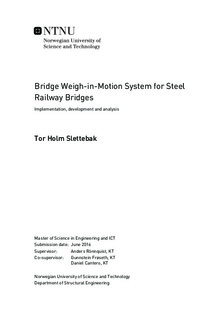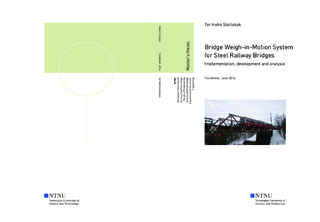| dc.description.abstract | This master thesis seeks to develop a BWIM system by using the programming environment Matlab, based on existing Bridge Weigh-in-Motion systems and the founding theories behind it. The developement uses a beam model to create a strain signal based on it's properties and moment influence line. The beam model is subjected to moving loads representing train axles, which induces strain at a sensor placed arbitrarily along the beam. To use as realistic a signal as possible through this model, white gaussian noise and dynamic effects are included in the signal. The resulting signal is used to develope and validate the BWIM algorithm. When the methods for finding speed and axle distances was within a decent level of accuracy, the developement of a linear matrix method for finding the influence lines was the next phase. This was based on the properties of the train inducing the signal and the signal itself. This thesis shows how the different elements of a BWIM program can be solved programaticly.
The thesis' empirical data was collected from Leirelva railway bridge, where a setup of strain gauges measured the bridge response for in all 6 different trains.
This data was then used to analyse how a BWIM system would perform for this typical early 1900's Norwegian steel railway bridge. Identifying the passing trains velocities proved to be of particular importance to the BWIM system. The velocities of the trains were found through a brute force method. The matrix method proved to perform well for all the different signals, creating a influence line capable of nearly recreating the original signal, given the speed, and axle distances and weight. However, since the actual train weights was unattainable it was not possible to control the identified influence lines by using them to calculate the axle weights for comparison. The final influence lines used for calculation of axle weights, was obtained by averaging the results for the different train passages and a final filtering to rid the resulting influence line of unwanted noise.
This thesis highlights the difficulties of developing a BWIM system. By analysing how it performed for the data material from Leirelva bridge, the thesis shows that a BWIM system likely will work for these types of bridges. | |

